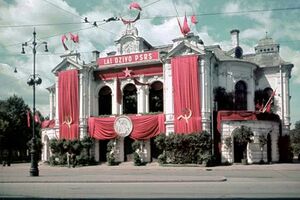Social:Sovietization

Sovietization (Russian: советизация, romanized: sovyetizatsiya) is the adoption of a political system based on the model of soviets (workers' councils) or the adoption of a way of life, mentality, and culture modeled after the Soviet Union. This often included adopting the Cyrillic script and sometimes also the Russian language.
A notable wave of Sovietization (in the second meaning) occurred during the Russian Civil War in the territories captured by the Red Army. Later, the territories occupied by the Russian SFSR and the USSR were Sovietized. Mongolia was conquered by the Soviet Union and Sovietized in the 1920s, and after the end of the Second World War, Sovietization took place in the countries of the Soviet Bloc (Eastern and Central Europe: Czechoslovakia, East Germany, Hungary, Poland, the Baltic states, etc.).[1][2] In a broad sense, it included the involuntary creation of Soviet-style authorities, imitation of elections held under the control of the Bolsheviks with the removal of opposition candidates, nationalization of land and property, repression against representatives of "class enemies" (kulaks, or osadniks, for instance). Mass executions and imprisoning in Gulag labor camps and exile settlements often accompany that process. This was usually promoted and sped up by propaganda aimed at creating a common way of life in all states within the Soviet sphere of influence. In modern history, Sovietization refers to the copying of models of Soviet life (the cult of the leader's personality, collectivist ideology, mandatory participation in propaganda activities, etc.).[3][4][5]
In a narrow sense, the term Sovietization is often applied to mental and social changes within the population of the Soviet Union and its satellites,[6] which led to creation of the new Soviet man (according to its supporters) or Homo Sovieticus (according to its critics).[7][8]
See also
- Establishment of Soviet power in Russia (1917–1918)
- Sovietization of the Baltic states
- Soviet patriotism
- Soviet empire
- Russification
- Korenizatsiia
- National delimitation in the Soviet Union
References
- ↑ С. Кульчицький. Радянська влада // Політична енциклопедія. — p.620
- ↑ С. Кульчицький. Радянський комунізм // Політична енциклопедія. — p.621
- ↑ Myron Weiner, Sharon Stanton Russell, ed (2001). "Stalinist Forced Relocation Policies". Demography and National Security. Berghahn Books. pp. 308–315. ISBN 1-57181-339-X. https://books.google.com/books?id=J9nuv7MGQ5MC&q=Sovietization&pg=PA309.
- ↑ Совєтизація // Українська мала енциклопедія : 16 кн. : у 8 т. / проф. Є. Онацький. — Накладом Адміністратури УАПЦ в Аргентині. — Буенос-Айрес, 1965. — Т. 7, кн. XIV : Літери Сен — Сті. — С. 1717—1844. — 1000 екз.
- ↑ Про радянізацію[|permanent dead link|dead link}}]
- ↑ Józef Tischner (2005) (in pl). Etyka solidarności oraz Homo sovieticus. Kraków: Znak. p. 295. ISBN 83-240-0588-9.
- ↑ Aleksandr Zinovyev (1986). Homo sovieticus. Grove/Atlantic. ISBN 0-87113-080-7.
- ↑ Барташук Олеся Наслідки запровадження радянської обрядовості (60–80-і рр. ХХ ст.): аналіз історико-етнографічних матеріалів календарного циклу Хмельницького Поділля // Мандрівець Науковий журнал. — 2008, No. 7
Further reading
- Edward J. O'Boyle (January 1993). "Work Habits and Customer Service in Post-Communist Poland". International Journal of Social Economics 20 (1).
- Weeks, Theodore R. (2010), Russification / Sovietization, EGO - European History Online, Mainz: Institute of European History, retrieved: March 25, 2021 (pdf).
 |

